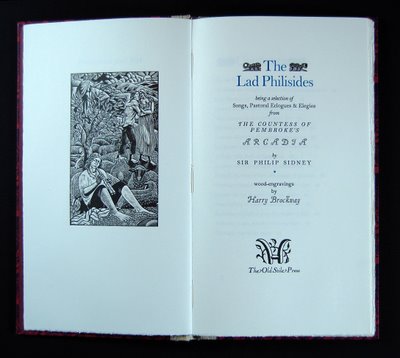. . . things are beginning to bubble up nicely! At the beginning of work on any book it seems that weeks if not months of solid work go by and nothing seems to have been achieved. I print text on one side of a sheet but I know that that sheet must have text on the other side and then two (or sometimes four or six) further printings of blocks before that sheet is finished.

With the sheet in this photograph, I have at last reached that point. There is already text and imagery on the other side so, after these final images have dried, the sheet will be ready to be guillotined and then folded and collated with the other signatures to form the final book. When this point is reached, each day is likely to produce another sheet ready to be passed over to Frances for these final rites - including, we hope, the weeding out of any sheet that has acquired somehow an inky fingermark from the printer, although I rather think that these should be charged extra for!

This book is the wonderfully erotic poem,
Black Marigolds, translated by E. Powys Mathers from the Sanskrit. The images are by Glenys Cour whose work for Vernon Watkins'
Taliesin and the Mockers has been so much admired. The technique (although subject matter and format of book give a quite different feel this time) is the same as in the earlier book . . . collages of black and white paper and white paper given a patterning in black by such techniques as monotype, stippling and so on. In the photograph above, Glenys' original collage is on the right while my printing is on the left, with a verse of the poem. The gold-coloured thing above is the photo-polymer block which I made from the original and with which I printed my version.
While taking these photos, I suddenly thought that I would give to the world an uncensored view of the environment in which I work! At the start of a new book-building project I do start off with a clear table and most things 'put away'. As the process continues, tools and other things are laid out and must fall under the hand when needed again. I am sure it will be clear to all that everything in these photographs is exactly where it should be and any misguided tidying-up would be completely disastrous.
I have sometimes been shown into printing offices which look more like operating theatres or smart Show Houses than anything I would recognize as a place I could inhabit for many hours each day. In fact such places really give me the willies!

In the background of this other photograph (below) is my guillotine - made at the turn of the (previous!) century and still going perfectly. All it needs is a really sharp blade and a strongish arm to turn the handle. It is, incidentally, totally without safely features of any kind. 'Health and Safety' addicts would get the vapours just to look at it! If I, alone, use it then that is legally OK. If anyone else was to use it, however, I could be had up immediately. Hence (as all my other machinery is of similar vintage and degree of lethality) we can allow no assistants, students or helpers of any other sort.

If cars 'run' on petrol and sheep on grass, I 'run' on music! My cordless headphones are on all the time and there is always a CD somewhere that will answer my mood!

Back, finally, to the work in hand . . . an opportunity to compare more closely the original against what the process-camera 'saw' and what the block made of it.











 Knowing, as I do, that half the world is agog to discover every feature and happening of 'our' river, I felt that I must waste a moment of your time with the following!
Knowing, as I do, that half the world is agog to discover every feature and happening of 'our' river, I felt that I must waste a moment of your time with the following!
















 It is quite dramatic, though. What those of you who have not yet come to visit us and seen the Wye in its detumescent state, as it were, have to realize is that the trees you can see in both of these photos - the ones which are sticking up out of the water - these are all on OUR side of the river.
It is quite dramatic, though. What those of you who have not yet come to visit us and seen the Wye in its detumescent state, as it were, have to realize is that the trees you can see in both of these photos - the ones which are sticking up out of the water - these are all on OUR side of the river. There is no reason whatever for posting all this. I do it simply because I am taking the greatest delight in being able to! The fact that I can take some photos this morning, fiddle a bit on the computer and then friendly blog-followers in Orkney (hello Norman!) or Australia (hello Guy!), or wherever, can know precise, if totally unimportant, details about our lives as if they lived next door . . . is just fun and friendly and generally life-enhancing!
There is no reason whatever for posting all this. I do it simply because I am taking the greatest delight in being able to! The fact that I can take some photos this morning, fiddle a bit on the computer and then friendly blog-followers in Orkney (hello Norman!) or Australia (hello Guy!), or wherever, can know precise, if totally unimportant, details about our lives as if they lived next door . . . is just fun and friendly and generally life-enhancing!